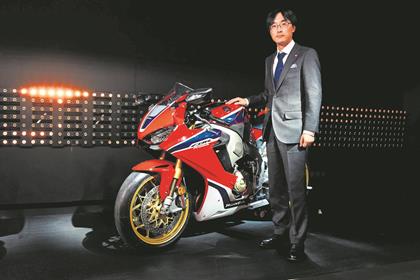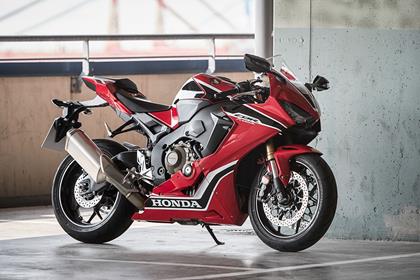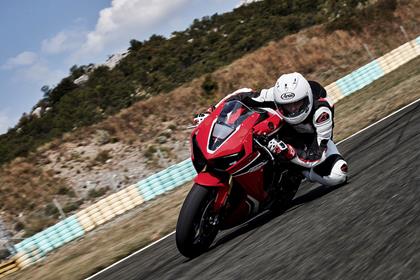How the 2017 Honda Fireblade was made
Honda unveiled the new Fireblade at EICMA last week, so MCN sat down with Masatoshi Sato, the Large Project leader, to find out the key to their success.
MCN: What was the ultimate goal for the Fireblade range and how did you know when you had achieved that goal?
MS: “The overall target and purpose was to express what the Fireblade has always been about, which is the pure enjoyment of riding. This time, with the three Fireblades, in a way that is greater than ever before, we have created a bike that is totally focused on circuit riding.
“The moment when we realised we had succeeded was when we were riding the first prototypes and we could feel the ultimate lightness of the handling, we were under control and the bikes were responding to our inputs exactly how we wanted. We knew then that we had expressed the fun and joy of riding as we had envisioned it.”
TOP STORIES
- MotoGP: Lorenzo bids farewell to Yamaha with Valencia masterclass
- Moto Guzzi revamp V7
- Moto3: Binder bounces back to end on a high
- Get a clear idea when buying a used bike
- Moto2: Champion Zarco signs off with victory
MCN: The headline figure is a drop of 15kg, including 2kg from the engine alone. Where did the majority of the other savings come from?
MS: “The weight saving is from all over but the single biggest one was the new ABS system. The titanium muffler on the standard bike made a big saving as well. The brake calipers are also lighter, plus the standard bike saves some weight over the electronic components in the Ohlins suspension.
“Apart from those big items the rest came from a review of almost every single part – we’ve actually changed over 90% of the parts from the previous model. We looked at everything from the length of the coolant hoses to the lengths of engine bolts to try and find some weight savings.”
MCN: Since you’ve mentioned it – the outgoing ABS was a Honda unit, is the new one from Bosch? If it is, why does Honda list it as 5-axis, unlike the competitors 6-axis unit?
MS: “The calipers are Nissin, which we have developed together. The gyro sensor is a Bosch unit – we call it a 5-axis because that’s how it measures. You can extrapolate a sixth axis from the measurements the unit takes, so some companies call it a 6-axis but ultimately it’s the same.”
![]()
MCN: Many competitors are claiming power numbers in excess of 200bhp, is there a reason Honda did not chase such a power output?
MS: “Fireblade has never been about chasing outright power. From the very first 900 it has always been about making a lightweight bike because we think the first thing a rider feels on a bike is not the outright horsepower but the feeling you get the first time you lean the bike into a corner. Fireblade has never been about revving an engine to the absolute maximum.”
MCN: So are you saying increasing the power would compromise the ride quality?
MS: “If you go for more outright power the engine has to be much more durable, the frame has to be more rigid to translate the power, the suspension needs more ‘meat’ to cope with it. We could make that sort of bike but it would be a different sort of bike. It would not be a supersport bike.”
MCN: This is Honda’s first inline four with a ride-by-wire throttle. What challenges did this present?
MS: “It was a very big challenge to do this for the first time because we didn’t want it to feel any different from the cable throttle people are used to using. Developing something that feels as natural as it does, taking into account the electronic controls it has, was a big challenge to replicate that natural feeling.”
MCN: So was that the most difficult part of the entire design process?
MS: “Looking back there was a lot of very difficult parts: the titanium exhaust, changing the frame, fitting the Ohlins, the new ABS – there were lots of difficult parts to the project. The thing we spent the most time on, and in hindsight the hardest part, was the original planning phase when we were thinking about just what we wanted from the bike. But we think all that effort upfront has paid off, even if it was a very intense process to get to where we are now.”
MCN: There’s a lot of mention of low weight, was that in anyway influenced by the loss of the CBR600RR?
MS: “Well in that planning phase, something that came up was that if we made a Fireblade that was as dynamic as the 600, then that would be ideal. So it was talked about in the planning process, but the Fireblade was never designed with the intention of replacing the 600.”
MCN: What is the future of Fireblade in 10 or 15 years’ time – is it electric perhaps?
MS: “It’s hard to predict whether the driving force of a Fireblade will be a petrol powered engine or an electric motor but all we’d say is that however much time passes, the Fireblade concept will never change. All we worry about is that people will enjoy riding the bike, whatever bike that will be or however it will be powered.”
Looking for the perfect two-wheeled companion? Visit MCN Bikes For Sale website or use MCN’s Bikes For Sale App.






